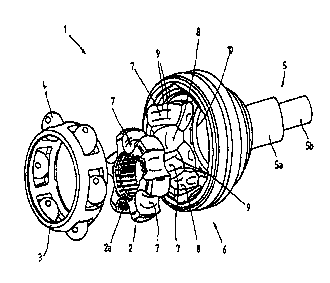Some of the information on this Web page has been provided by external sources. The Government of Canada is not responsible for the accuracy, reliability or currency of the information supplied by external sources. Users wishing to rely upon this information should consult directly with the source of the information. Content provided by external sources is not subject to official languages, privacy and accessibility requirements.
Any discrepancies in the text and image of the Claims and Abstract are due to differing posting times. Text of the Claims and Abstract are posted:
| (12) Patent Application: | (11) CA 2313185 |
|---|---|
| (54) English Title: | METHOD FOR FINISHING THE BALL CUP OF A HOMOCINITIC JOINT |
| (54) French Title: | PROCEDE POUR LE FINISSAGE DU COUSSINET SPHERIQUE D'UN JOINT HOMOCINETIQUE |
| Status: | Deemed Abandoned and Beyond the Period of Reinstatement - Pending Response to Notice of Disregarded Communication |
| (51) International Patent Classification (IPC): |
|
|---|---|
| (72) Inventors : |
|
| (73) Owners : |
|
| (71) Applicants : |
|
| (74) Agent: | GOWLING WLG (CANADA) LLP |
| (74) Associate agent: | |
| (45) Issued: | |
| (86) PCT Filing Date: | 1998-12-02 |
| (87) Open to Public Inspection: | 1999-06-17 |
| Availability of licence: | N/A |
| Dedicated to the Public: | N/A |
| (25) Language of filing: | English |
| Patent Cooperation Treaty (PCT): | Yes |
|---|---|
| (86) PCT Filing Number: | PCT/EP1998/007843 |
| (87) International Publication Number: | WO 1999030054 |
| (85) National Entry: | 2000-06-06 |
| (30) Application Priority Data: | ||||||
|---|---|---|---|---|---|---|
|
The invention relates to a method for finishing the ball cup (6) of a
homocinitic joint, especially for motor vehicles, having a ball ring-shaped
bearing surface (8) for the ball cage (3) and a plurality of essentially axial
running guideways (7) which interrupt said ball ring-shaped bearing surface.
The guideways are provided for the balls (4) which are arranged in the ball
recesses of the ball cage (3) and which transmit torque between the ball cup
(6) and the ball star (2). In order to be able to finish such ball shells (6)
quickly, economically and as fully automatic as possible, the invention
provides that both the ball ring-shaped bearing surface (8) for the ball cage
(3) as well as the guideways (7) for the balls (4) are produced by means of a
turning machining.
L'invention concerne un procédé pour le finissage du coussinet sphérique (6) d'un joint homocinétique, notamment pour des véhicules automobiles, comportant une surface d'appui (8) en forme de bague à billes, destinée à la cage à billes (3), et une pluralité de glissières de guidage (7) interrompant ladite surface d'appui (8), s'étendant sensiblement axialement et destinées aux billes (4) disposées dans les évidements sphériques de la cage à billes (3) et transmettant des couples de rotation entre le coussinet sphérique (6) et le croisillon sphérique (2). Dans le but de pouvoir assurer le finissage de tels coussinets sphériques (6) de manière rapide, économique et aussi automatisée que possible, tant la surface d'appui (8) en forme de bague à billes et destinée à la cage à billes (3) que les glissières de guidage (7) destinées aux billes (4) sont réalisées par usinage sur tour.
Note: Claims are shown in the official language in which they were submitted.
Note: Descriptions are shown in the official language in which they were submitted.

2024-08-01:As part of the Next Generation Patents (NGP) transition, the Canadian Patents Database (CPD) now contains a more detailed Event History, which replicates the Event Log of our new back-office solution.
Please note that "Inactive:" events refers to events no longer in use in our new back-office solution.
For a clearer understanding of the status of the application/patent presented on this page, the site Disclaimer , as well as the definitions for Patent , Event History , Maintenance Fee and Payment History should be consulted.
| Description | Date |
|---|---|
| Inactive: IPC assigned | 2017-10-11 |
| Inactive: IPC deactivated | 2015-08-29 |
| Inactive: First IPC assigned | 2015-07-06 |
| Inactive: IPC assigned | 2015-07-06 |
| Inactive: IPC expired | 2011-01-01 |
| Application Not Reinstated by Deadline | 2003-12-02 |
| Time Limit for Reversal Expired | 2003-12-02 |
| Deemed Abandoned - Failure to Respond to Maintenance Fee Notice | 2002-12-02 |
| Letter Sent | 2000-11-09 |
| Inactive: Cover page published | 2000-08-22 |
| Inactive: First IPC assigned | 2000-08-16 |
| Inactive: Courtesy letter - Evidence | 2000-08-15 |
| Inactive: Notice - National entry - No RFE | 2000-08-10 |
| Application Received - PCT | 2000-08-08 |
| Application Published (Open to Public Inspection) | 1999-06-17 |
| Abandonment Date | Reason | Reinstatement Date |
|---|---|---|
| 2002-12-02 |
The last payment was received on 2001-12-03
Note : If the full payment has not been received on or before the date indicated, a further fee may be required which may be one of the following
Please refer to the CIPO Patent Fees web page to see all current fee amounts.
| Fee Type | Anniversary Year | Due Date | Paid Date |
|---|---|---|---|
| Basic national fee - standard | 2000-06-06 | ||
| MF (application, 2nd anniv.) - standard | 02 | 2000-12-04 | 2000-06-06 |
| Registration of a document | 2000-10-11 | ||
| MF (application, 3rd anniv.) - standard | 03 | 2001-12-03 | 2001-12-03 |
Note: Records showing the ownership history in alphabetical order.
| Current Owners on Record |
|---|
| IPROTEC MASCHINEN- UND EDELSTAHLPRODUKTE GMBH |
| Past Owners on Record |
|---|
| GUIDO KOCHSIEK |